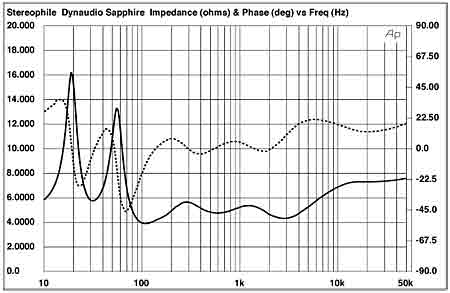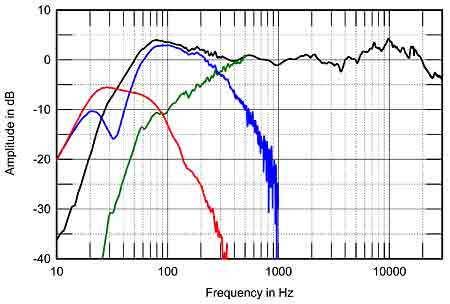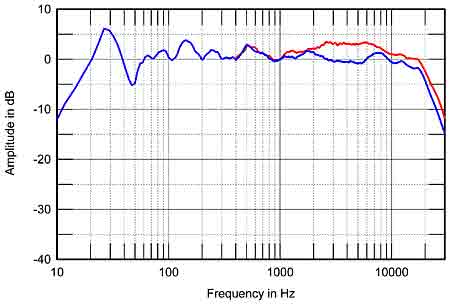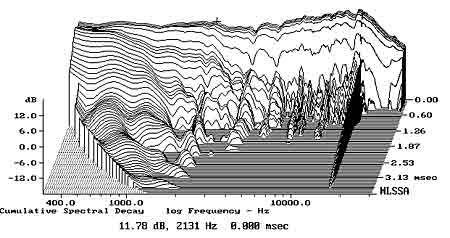| Columns Retired Columns & Blogs |
Dynaudio Sapphire loudspeaker Measurements
Sidebar 3: Measurements
The Dynaudio Sapphire's voltage sensitivity is specified as 88dB/2.83V/m. My B-weighted estimate on the speaker's tweeter axis, calculated by DRA Labs' MLSSA system with a calibrated DPA omnidirectional microphone, was a little higher, at 89.2dB(B)/2.83V/m, but I suspect this was because I performed the measurement with the grille removed (see later). The impedance remains between 4 and 6 ohms over most of the audioband (fig.1, solid trace), with an electrical phase angle (fig.1, dashed trace) that remains low. Though there is a combination of 5.3 ohms magnitude and –45° capacitive phase angle just above 70Hz, the Sapphire will offer no drive difficulty to a good amplifier rated at 4 ohms. With the port blocked, the impedance-magnitude trace (not shown) featured a single low-frequency peak at 47Hz, the sealed-box tuning frequency. This suggests that the speaker's LF extension will be rather more curtailed than I would have expected in this condition.

Fig.1 Dynaudio Sapphire, electrical impedance (solid) and phase (dashed). (2 ohms/vertical div.)
The impedance traces are free from the small discontinuities that would suggest the existence of panel resonances of various kinds, and I found the glossy, faceted section of the Sapphire's cabinet to be very inert. However, the rectangular, matte-black section of the enclosure did suffer from a single strong resonant mode just under 200Hz (fig.2). I heard no congestion in this region, so I suspect that the area of the affected panel is small enough that, coupled with the fact that it faces away from the listener, it doesn't transfer the resonance to the air to a sufficient enough degree to introduce coloration.

Fig.2 Dynaudio Sapphire, cumulative spectral-decay plot calculated from output of accelerometer fastened to center of head-unit side panel (MLS driving voltage to speaker, 7.55V; measurement bandwidth, 2kHz).
The saddle centered on 32Hz between the twin low-frequency peaks in the impedance-magnitude trace suggests that this is the tuning frequency of the 3.5"-diameter port, and indeed, the nearfield measurement of the woofers' output (fig.3, blue trace) does feature a notch at that frequency (at which the back pressure from the port resonance holds the woofer cones still). The port's response (fig.3, red trace) is suppressed a little, the Sapphire's reflex alignment being optimized for clarity rather than ultimate bass weight. The port's output rolls off cleanly above 80Hz, without any midrange pipe resonances evident.

Fig.3 Dynaudio Sapphire, anechoic response on tweeter axis at 50" without grille (black), averaged across 30° horizontal window and corrected for microphone response, with nearfield responses of woofer (blue), head-unit port (green), and subwoofer (red), plotted in the ratios of the square roots of their radiating areas below 300Hz, 500Hz, and 850Hz, respectively, and the complex sum of nearfield responses plotted below 300Hz (black).
Higher in frequency, the woofers cross over to the midrange unit (fig.3, green trace) around 300Hz, which is lower than specified, with shallow filter slopes in the first couple of out-of-band octaves. The woofers behave identically, and roll off smoothly above crossover. Both the midrange unit and the tweeter offer flat responses within their respective passbands, though the tweeter appears to be balanced 2–3dB too high in level. This curve was taken with the grille removed; adding it leaves the tweeter's on-axis level unchanged, but pulls down the output between 3 and 5kHz by 2–3dB.
Fig.4 shows the Sapphire's lateral dispersion with the grille removed, normalized to the farfield response on the tweeter axis, which therefore appears in this graph as a straight line. The contour lines are generally smooth and evenly spaced, correlating with the stable stereo imaging noted in the auditioning, but there is a touch of off-axis flare at the bottom of the tweeter's passband, and the tweeter becomes quite directional above 10kHz. Vertically (fig.5), the small suckout between 3 and 4kHz in the Sapphire's tweeter-axis response fills in for microphone positions below that axis. As the tweeter is a high 45" from the ground, this is sensible behavior. A suckout develops in the upper crossover region more than 5° above the tweeter axis; as always, don't listen to this speaker while standing.

Fig.4 Dynaudio Sapphire, lateral response family at 50", normalized to response on tweeter axis, from back to front: differences in response 90–5° off axis, reference response, differences in response 5–90° off axis.

Fig.5 Dynaudio Sapphire, vertical response family at 50", normalized to response on tweeter axis, from back to front: differences in response 15–5° above axis, reference response, differences in response 5–15° below axis.
For more than 20 years now, I have been looking at how a speaker's quasi-anechoic measured response translates into how it behaves in the listening room by averaging the responses of the left and right speakers taken individually in a vertical rectangular grid 36" wide by 18" high, centered on the position of my ears in my listening chair. I used to use 1/3-octave analyzers from first Heathkit, then AudioControl, but these days I use Fuzzmeasure 2.0 from SMUG Software running on my Macintosh Powerbook, in conjunction with a FireWire audio interface from Metric Halo. The result for the pair of Dynaudio Sapphires is shown in fig.6, first without the grilles (red trace), then with them (blue). Leaving the grilles off clearly leads to an excess of energy in the mid-treble, which is why I found the speakers too bright in my room with music that was already overcooked in that region. While the grille doesn't reduce the level of the tweeter on-axis, the thick layer of felt with which it surrounds the dome kills off the off-axis flare seen in the lateral-dispersion plot, resulting in a much more even in-room response throughout the treble (blue trace).

Fig.6 Dynaudio Sapphire, spatially averaged, 1/6-octave response in JA's listening room with grille (blue) and without (red).
Lower in frequency, the dip between 40 and 60Hz and the peak between 20 and 40Hz are residual room effects that have not been eliminated by the spatial averaging. The peak is also affected by the fact that the tuning frequency of the Sapphire's reflex port coincides with the lowest-frequency diagonal mode of my room acoustic, which added a not-unpleasant phat character to the speaker's low-bass balance.
Turning to the time domain, the Sapphire's step response on the tweeter axis (fig.7) indicates that the tweeter and woofers are connected in positive acoustic polarity, the midrange unit in negative polarity. This results in the decay of each one's step smoothly integrating with the rise of that of the next lower in frequency, which correlates with the excellent frequency-domain integration of their outputs seen in fig.3.

Fig.7 Dynaudio Sapphire, step response on tweeter axis at 50" (5ms time window, 30kHz bandwidth).
Finally, the Dynaudio's farfield waterfall plot on the tweeter axis (fig.8) shows a quick, clean decay throughout the upper midrange and treble, though some low-level hash, perhaps from the midrange unit's cone, can be seen between 2 and 5kHz.—John Atkinson

Fig.8 Dynaudio Sapphire, cumulative spectral-decay plot on tweeter axis at 50" (0.15ms risetime).
- Log in or register to post comments




































